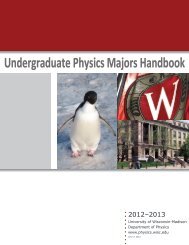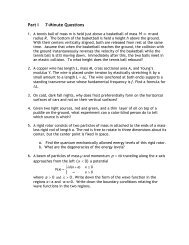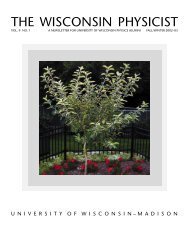neutrino
neutrino
neutrino
You also want an ePaper? Increase the reach of your titles
YUMPU automatically turns print PDFs into web optimized ePapers that Google loves.
than the value required for a thermal relic abundance<br />
[34]: 〈σv〉 0 =3× 10 −26 cm 3 s −1 . Following the current<br />
convention, we write<br />
〈σv〉 = B 〈σv〉 0 , (1)<br />
with a boost factor B. There are theoretical evaluations<br />
of the boost factor [35], however, we treat the boost factor<br />
as a phenomenological parameter in this paper. To<br />
explain the lepton excesses, some models have constraints<br />
on the boost factor as a function of DM mass [16].<br />
In leptophilic DM<br />
models [7, 16] explaining the<br />
PAMELA positron excess, the DM annihilation or decay<br />
must proceed dominantly to leptons in order to avoid<br />
the overproduction of antiprotons. Moreover, according<br />
to the FERMI data, the direct production of electrons<br />
must be suppressed with respect to the production of<br />
electrons (and positrons) as secondaries. It was shown<br />
[16] that the leptophilic DM with mass (m χ ) in the range<br />
between 150 GeV and a few TeV, which annihilates or<br />
decays into τ’s or µ’s can fit the PAMELA [4] and Fermi<br />
[5] data as well as the HESS high energy photon data [6].<br />
The best fit parameters for the boost factor (B) andthe<br />
decay time (τ) which determine the overall normalizations,<br />
for the specific case involving muons from annihilation<br />
(χχ → µ + µ − )ordecay(χ → µ + µ − ), respectively,<br />
are given by [16]<br />
B = 431m χ − 38.9<br />
τ =<br />
(<br />
2.29 + 1.182<br />
m χ )<br />
× 10 26 sec<br />
= B τ × 10 26 sec (2)<br />
for m χ in TeV. The annihilation channel into tau pairs<br />
is less favored by the data [16].<br />
Some Kaluza-Klein models can provide a DM candidate<br />
which gives the correct relic density [30].<br />
To account<br />
for the HESS results [6], the lightest Kaluza-Klein<br />
particle (LKP) would have a mass of the order of a TeV<br />
[14]. The LKP is also assumed to be neutral and nonbaryonic.<br />
In this model, the particle couplings are fixed<br />
such that LKP pairs annihilate into quark pairs (35%),<br />
charged lepton pairs (59%), <strong>neutrino</strong>s (4%), gauge bosons<br />
(1.5%) and higgs bosons (0.5%) [14, 30].<br />
The first DM candidate proposed in the context of supersymmetry<br />
is the gravitino (ψ 3/2 ) which would be the<br />
lightest supersymmetric particle (LSP). The gravitino is<br />
the superpartner of the graviton. With the existence of<br />
small R-parity breaking to allow the LSP to decay, the<br />
gravitino decays into standard model particles. The decay<br />
rate of the gravitino in this scenario is so small that<br />
it can have a sufficiently long lifetime for the correct DM<br />
relic density today.<br />
GeV and few TeV [17]. To explain the data, the threebody<br />
gravitino decay mode (ψ 3/2 → l + l − ν) was considered<br />
[17]. We use the parameters of this model to explore<br />
<strong>neutrino</strong> signals from gravitino decay. For illustration, in<br />
addition to three-body decay, we also consider the twobody<br />
gravitino decay modes (ψ 3/2<br />
→ (W ∓ l ± ,Zν, γν))<br />
assuming the same lifetime and mass as for the threebody<br />
decay, and with the branching fractions given in<br />
Table I.<br />
m ψ3/2 (GeV) B F (ψ 3/2 → γν) B F (ψ 3/2 → Wl) B F (ψ 3/2 → Zν)<br />
10 1 0 0<br />
85 0.66 0.34 0<br />
100 0.16 0.76 0.08<br />
150 0.05 0.71 0.24<br />
200 0.03 0.69 0.28<br />
400 0.03 0.68 0.29<br />
TABLE I: Branching fractions for the two-body gravitino<br />
decay into different R-parity violating channels for different<br />
masses [15].<br />
Particle/mode mass B τ or B<br />
ψ 3/2 → l + l − ν 400 GeV B τ =2.3<br />
ψ 3/2 → (Wl,Zν, γν) 400 GeV B τ =2.3<br />
χ → µ + µ − 2TeV B τ =2.9<br />
B (1) B (1) → (q¯q, l + l − ,W + W − ,ZZ,ν¯ν) 800GeVB =200<br />
χχ → µ + µ − 1TeV B =400<br />
TABLE II: Model parameters characterizing fits to explain<br />
FERMI and PAMELA anomalies used as examples in this<br />
paper.<br />
Selected DM model parameters are shown in Table II.<br />
For each of the DM models considered, the decay distribution<br />
of the produced particles to <strong>neutrino</strong>s in case<br />
of DM annihilation, or the gravitino decay distribution<br />
to <strong>neutrino</strong>s, enters into the calculation of the <strong>neutrino</strong><br />
fluxes that arrive at Earth. For annihilation directly to<br />
<strong>neutrino</strong>s, the energy distribution of each <strong>neutrino</strong> is a<br />
delta function in energy, with the energy equal to the DM<br />
mass. This case has been well studied in the literature<br />
[21, 31, 32, 36]. Here, we look at the secondary <strong>neutrino</strong>s.<br />
Fig. 1 shows <strong>neutrino</strong> spectra, plotted in terms<br />
of x ≡ E ν /E ν,max where E ν,max = m χ for annihilating<br />
DM and E ν,max = m χ /2 for decaying DM models. The<br />
curves in the figure are normalized to count the number<br />
of <strong>neutrino</strong>s, and in the case of the Zν final state, the<br />
fraction of Z decays to <strong>neutrino</strong>s. The muon <strong>neutrino</strong><br />
spectra in the figure should be multiplied by the branching<br />
fraction for a specific decay channel in a given model.<br />
than the value required for a thermal relic abundance<br />
[34]: 〈σv〉 0 =3× 10 −26 cm 3 s −1 . Following the current<br />
convention, we write<br />
〈σv〉 = B 〈σv〉 0 , (1)<br />
with a boost factor B. There are theoretical evaluations<br />
of the boost factor [35], however, we treat the boost factor<br />
as a phenomenological parameter in this paper. To<br />
explain the lepton excesses, some models have constraints<br />
on the boost factor as a function of DM mass [16].<br />
In leptophilic DM<br />
models [7, 16] explaining the<br />
PAMELA positron excess, the DM annihilation or decay<br />
must proceed dominantly to leptons in order to avoid<br />
the overproduction of antiprotons. Moreover, according<br />
to the FERMI data, the direct production of electrons<br />
must be suppressed with respect to the production of<br />
electrons (and positrons) as secondaries. It was shown<br />
[16] that the leptophilic DM with mass (m χ ) in the range<br />
between 150 GeV and a few TeV, which annihilates or<br />
decays into τ’s or µ’s can fit the PAMELA [4] and Fermi<br />
[5] data as well as the HESS high energy photon data [6].<br />
The best fit parameters for the boost factor (B) andthe<br />
decay time (τ) which determine the overall normalizations,<br />
for the specific case involving muons from annihilation<br />
(χχ → µ + µ − )ordecay(χ → µ + µ − ), respectively,<br />
are given by [16]<br />
B = 431m χ − 38.9<br />
τ =<br />
(<br />
2.29 + 1.182<br />
m χ )<br />
× 10 26 sec<br />
= B τ × 10 26 sec (2)<br />
for m χ in TeV. The annihilation channel into tau pairs<br />
is less favored by the data [16].<br />
Some Kaluza-Klein models can provide a DM candidate<br />
which gives the correct relic density [30].<br />
To account<br />
for the HESS results [6], the lightest Kaluza-Klein<br />
particle (LKP) would have a mass of the order of a TeV<br />
[14]. The LKP is also assumed to be neutral and nonbaryonic.<br />
In this model, the particle couplings are fixed<br />
such that LKP pairs annihilate into quark pairs (35%),<br />
charged lepton pairs (59%), <strong>neutrino</strong>s (4%), gauge bosons<br />
(1.5%) and higgs bosons (0.5%) [14, 30].<br />
The first DM candidate proposed in the context of supersymmetry<br />
is the gravitino (ψ 3/2 ) which would be the<br />
lightest supersymmetric particle (LSP). The gravitino is<br />
the superpartner of the graviton. With the existence of<br />
small R-parity breaking to allow the LSP to decay, the<br />
gravitino decays into standard model particles. The decay<br />
rate of the gravitino in this scenario is so small that<br />
it can have a sufficiently long lifetime for the correct DM<br />
relic density today.<br />
GeV and few TeV [17]. To explain the data, the threebody<br />
gravitino decay mode (ψ 3/2 → l + l − ν) was considered<br />
[17]. We use the parameters of this model to explore<br />
<strong>neutrino</strong> signals from gravitino decay. For illustration, in<br />
addition to three-body decay, we also consider the twobody<br />
gravitino decay modes (ψ 3/2<br />
→ (W ∓ l ± ,Zν, γν))<br />
assuming the same lifetime and mass as for the threebody<br />
decay, and with the branching fractions given in<br />
Table I.<br />
m ψ3/2 (GeV) B F (ψ 3/2 → γν) B F (ψ 3/2 → Wl) B F (ψ 3/2 → Zν)<br />
10 1 0 0<br />
85 0.66 0.34 0<br />
100 0.16 0.76 0.08<br />
150 0.05 0.71 0.24<br />
200 0.03 0.69 0.28<br />
400 0.03 0.68 0.29<br />
TABLE I: Branching fractions for the two-body gravitino<br />
decay into different R-parity violating channels for different<br />
masses [15].<br />
Particle/mode mass B τ or B<br />
ψ 3/2 → l + l − ν 400 GeV B τ =2.3<br />
ψ 3/2 → (Wl,Zν, γν) 400 GeV B τ =2.3<br />
χ → µ + µ − 2TeV B τ =2.9<br />
B (1) B (1) → (q¯q, l + l − ,W + W − ,ZZ,ν¯ν) 800GeVB =200<br />
χχ → µ + µ − 1TeV B =400<br />
TABLE II: Model parameters characterizing fits to explain<br />
FERMI and PAMELA anomalies used as examples in this<br />
paper.<br />
Selected DM model parameters are shown in Table II.<br />
For each of the DM models considered, the decay distribution<br />
of the produced particles to <strong>neutrino</strong>s in case<br />
of DM annihilation, or the gravitino decay distribution<br />
to <strong>neutrino</strong>s, enters into the calculation of the <strong>neutrino</strong><br />
fluxes that arrive at Earth. For annihilation directly to<br />
<strong>neutrino</strong>s, the energy distribution of each <strong>neutrino</strong> is a<br />
delta function in energy, with the energy equal to the DM<br />
mass. This case has been well studied in the literature<br />
[21, 31, 32, 36]. Here, we look at the secondary <strong>neutrino</strong>s.<br />
Fig. 1 shows <strong>neutrino</strong> spectra, plotted in terms<br />
of x ≡ E ν /E ν,max where E ν,max = m χ for annihilating<br />
DM and E ν,max = m χ /2 for decaying DM models. The<br />
curves in the figure are normalized to count the number<br />
of <strong>neutrino</strong>s, and in the case of the Zν final state, the<br />
fraction of Z decays to <strong>neutrino</strong>s. The muon <strong>neutrino</strong><br />
spectra in the figure should be multiplied by the branching<br />
fraction for a specific decay channel in a given model.<br />
than the value required for a thermal relic abundance<br />
[34]: 〈σv〉 0 =3× 10 −26 cm 3 s −1 . Following the current<br />
convention, we write<br />
〈σv〉 = B 〈σv〉 0 , (1)<br />
with a boost factor B. There are theoretical evaluations<br />
of the boost factor [35], however, we treat the boost factor<br />
as a phenomenological parameter in this paper. To<br />
explain the lepton excesses, some models have constraints<br />
on the boost factor as a function of DM mass [16].<br />
In leptophilic DM<br />
models [7, 16] explaining the<br />
PAMELA positron excess, the DM annihilation or decay<br />
must proceed dominantly to leptons in order to avoid<br />
the overproduction of antiprotons. Moreover, according<br />
to the FERMI data, the direct production of electrons<br />
must be suppressed with respect to the production of<br />
electrons (and positrons) as secondaries. It was shown<br />
[16] that the leptophilic DM with mass (m χ ) in the range<br />
between 150 GeV and a few TeV, which annihilates or<br />
decays into τ’s or µ’s can fit the PAMELA [4] and Fermi<br />
[5] data as well as the HESS high energy photon data [6].<br />
The best fit parameters for the boost factor (B) andthe<br />
decay time (τ) which determine the overall normalizations,<br />
for the specific case involving muons from annihilation<br />
(χχ → µ + µ − )ordecay(χ → µ + µ − ), respectively,<br />
are given by [16]<br />
B = 431m χ − 38.9<br />
τ =<br />
(<br />
2.29 + 1.182<br />
m χ )<br />
× 10 26 sec<br />
= B τ × 10 26 sec (2)<br />
for m χ in TeV. The annihilation channel into tau pairs<br />
is less favored by the data [16].<br />
Some Kaluza-Klein models can provide a DM candidate<br />
which gives the correct relic density [30].<br />
To account<br />
for the HESS results [6], the lightest Kaluza-Klein<br />
particle (LKP) would have a mass of the order of a TeV<br />
[14]. The LKP is also assumed to be neutral and nonbaryonic.<br />
In this model, the particle couplings are fixed<br />
such that LKP pairs annihilate into quark pairs (35%),<br />
charged lepton pairs (59%), <strong>neutrino</strong>s (4%), gauge bosons<br />
(1.5%) and higgs bosons (0.5%) [14, 30].<br />
The first DM candidate proposed in the context of supersymmetry<br />
is the gravitino (ψ 3/2 ) which would be the<br />
lightest supersymmetric particle (LSP). The gravitino is<br />
the superpartner of the graviton. With the existence of<br />
small R-parity breaking to allow the LSP to decay, the<br />
gravitino decays into standard model particles. The decay<br />
rate of the gravitino in this scenario is so small that<br />
it can have a sufficiently long lifetime for the correct DM<br />
relic density today.<br />
GeV and few TeV [17]. To explain the data, the threebody<br />
gravitino decay mode (ψ 3/2 → l + l − ν) was considered<br />
[17]. We use the parameters of this model to explore<br />
<strong>neutrino</strong> signals from gravitino decay. For illustration, in<br />
addition to three-body decay, we also consider the twobody<br />
gravitino decay modes (ψ 3/2<br />
→ (W ∓ l ± ,Zν, γν))<br />
assuming the same lifetime and mass as for the threebody<br />
decay, and with the branching fractions given in<br />
Table I.<br />
m ψ3/2 (GeV) B F (ψ 3/2 → γν) B F (ψ 3/2 → Wl) B F (ψ 3/2 → Zν)<br />
10 1 0 0<br />
85 0.66 0.34 0<br />
100 0.16 0.76 0.08<br />
150 0.05 0.71 0.24<br />
200 0.03 0.69 0.28<br />
400 0.03 0.68 0.29<br />
TABLE I: Branching fractions for the two-body gravitino<br />
decay into different R-parity violating channels for different<br />
masses [15].<br />
Particle/mode mass B τ or B<br />
ψ 3/2 → l + l − ν 400 GeV B τ =2.3<br />
ψ 3/2 → (Wl,Zν, γν) 400 GeV B τ =2.3<br />
χ → µ + µ − 2TeV B τ =2.9<br />
B (1) B (1) → (q¯q, l + l − ,W + W − ,ZZ,ν¯ν) 800GeVB =200<br />
χχ → µ + µ − 1TeV B =400<br />
TABLE II: Model parameters characterizing fits to explain<br />
FERMI and PAMELA anomalies used as examples in this<br />
paper.<br />
Selected DM model parameters are shown in Table II.<br />
For each of the DM models considered, the decay distribution<br />
of the produced particles to <strong>neutrino</strong>s in case<br />
of DM annihilation, or the gravitino decay distribution<br />
to <strong>neutrino</strong>s, enters into the calculation of the <strong>neutrino</strong><br />
fluxes that arrive at Earth. For annihilation directly to<br />
<strong>neutrino</strong>s, the energy distribution of each <strong>neutrino</strong> is a<br />
delta function in energy, with the energy equal to the DM<br />
mass. This case has been well studied in the literature<br />
[21, 31, 32, 36]. Here, we look at the secondary <strong>neutrino</strong>s.<br />
Fig. 1 shows <strong>neutrino</strong> spectra, plotted in terms<br />
of x ≡ E ν /E ν,max where E ν,max = m χ for annihilating<br />
DM and E ν,max = m χ /2 for decaying DM models. The<br />
curves in the figure are normalized to count the number<br />
of <strong>neutrino</strong>s, and in the case of the Zν final state, the<br />
fraction of Z decays to <strong>neutrino</strong>s. The muon <strong>neutrino</strong><br />
spectra in the figure should be multiplied by the branching<br />
fraction for a specific decay channel in a given model.<br />
than the value required for a thermal relic abundance<br />
[34]: 〈σv〉 0 =3× 10 −26 cm 3 s −1 . Following the current<br />
convention, we write<br />
〈σv〉 = B 〈σv〉 0 , (1)<br />
with a boost factor B. There are theoretical evaluations<br />
of the boost factor [35], however, we treat the boost factor<br />
as a phenomenological parameter in this paper. To<br />
explain the lepton excesses, some models have constraints<br />
on the boost factor as a function of DM mass [16].<br />
In leptophilic DM<br />
models [7, 16] explaining the<br />
PAMELA positron excess, the DM annihilation or decay<br />
must proceed dominantly to leptons in order to avoid<br />
the overproduction of antiprotons. Moreover, according<br />
to the FERMI data, the direct production of electrons<br />
must be suppressed with respect to the production of<br />
electrons (and positrons) as secondaries. It was shown<br />
[16] that the leptophilic DM with mass (m χ ) in the range<br />
between 150 GeV and a few TeV, which annihilates or<br />
decays into τ’s or µ’s can fit the PAMELA [4] and Fermi<br />
[5] data as well as the HESS high energy photon data [6].<br />
The best fit parameters for the boost factor (B) andthe<br />
decay time (τ) which determine the overall normalizations,<br />
for the specific case involving muons from annihilation<br />
(χχ → µ + µ − )ordecay(χ → µ + µ − ), respectively,<br />
are given by [16]<br />
B = 431m χ − 38.9<br />
τ =<br />
(<br />
2.29 + 1.182<br />
m χ )<br />
× 10 26 sec<br />
= B τ × 10 26 sec (2)<br />
for m χ in TeV. The annihilation channel into tau pairs<br />
is less favored by the data [16].<br />
Some Kaluza-Klein models can provide a DM candidate<br />
which gives the correct relic density [30].<br />
To account<br />
for the HESS results [6], the lightest Kaluza-Klein<br />
particle (LKP) would have a mass of the order of a TeV<br />
[14]. The LKP is also assumed to be neutral and nonbaryonic.<br />
In this model, the particle couplings are fixed<br />
such that LKP pairs annihilate into quark pairs (35%),<br />
charged lepton pairs (59%), <strong>neutrino</strong>s (4%), gauge bosons<br />
(1.5%) and higgs bosons (0.5%) [14, 30].<br />
The first DM candidate proposed in the context of supersymmetry<br />
is the gravitino (ψ 3/2 ) which would be the<br />
lightest supersymmetric particle (LSP). The gravitino is<br />
the superpartner of the graviton. With the existence of<br />
small R-parity breaking to allow the LSP to decay, the<br />
gravitino decays into standard model particles. The decay<br />
rate of the gravitino in this scenario is so small that<br />
it can have a sufficiently long lifetime for the correct DM<br />
relic density today.<br />
GeV and few TeV [17]. To explain the data, the threebody<br />
gravitino decay mode (ψ 3/2 → l + l − ν) was considered<br />
[17]. We use the parameters of this model to explore<br />
<strong>neutrino</strong> signals from gravitino decay. For illustration, in<br />
addition to three-body decay, we also consider the twobody<br />
gravitino decay modes (ψ 3/2<br />
→ (W ∓ l ± ,Zν, γν))<br />
assuming the same lifetime and mass as for the threebody<br />
decay, and with the branching fractions given in<br />
Table I.<br />
m ψ3/2 (GeV) B F (ψ 3/2 → γν) B F (ψ 3/2 → Wl) B F (ψ 3/2 → Zν)<br />
10 1 0 0<br />
85 0.66 0.34 0<br />
100 0.16 0.76 0.08<br />
150 0.05 0.71 0.24<br />
200 0.03 0.69 0.28<br />
400 0.03 0.68 0.29<br />
TABLE I: Branching fractions for the two-body gravitino<br />
decay into different R-parity violating channels for different<br />
masses [15].<br />
Particle/mode mass B τ or B<br />
ψ 3/2 → l + l − ν 400 GeV B τ =2.3<br />
ψ 3/2 → (Wl,Zν, γν) 400 GeV B τ =2.3<br />
χ → µ + µ − 2TeV B τ =2.9<br />
B (1) B (1) → (q¯q, l + l − ,W + W − ,ZZ,ν¯ν) 800GeVB =200<br />
χχ → µ + µ − 1TeV B =400<br />
TABLE II: Model parameters characterizing fits to explain<br />
FERMI and PAMELA anomalies used as examples in this<br />
paper.<br />
Selected DM model parameters are shown in Table II.<br />
For each of the DM models considered, the decay distribution<br />
of the produced particles to <strong>neutrino</strong>s in case<br />
of DM annihilation, or the gravitino decay distribution<br />
to <strong>neutrino</strong>s, enters into the calculation of the <strong>neutrino</strong><br />
fluxes that arrive at Earth. For annihilation directly to<br />
<strong>neutrino</strong>s, the energy distribution of each <strong>neutrino</strong> is a<br />
delta function in energy, with the energy equal to the DM<br />
mass. This case has been well studied in the literature<br />
[21, 31, 32, 36]. Here, we look at the secondary <strong>neutrino</strong>s.<br />
Fig. 1 shows <strong>neutrino</strong> spectra, plotted in terms<br />
of x ≡ E ν /E ν,max where E ν,max = m χ for annihilating<br />
DM and E ν,max = m χ /2 for decaying DM models. The<br />
curves in the figure are normalized to count the number<br />
of <strong>neutrino</strong>s, and in the case of the Zν final state, the<br />
fraction of Z decays to <strong>neutrino</strong>s. The muon <strong>neutrino</strong><br />
spectra in the figure should be multiplied by the branching<br />
fraction for a specific decay channel in a given model.<br />
than the value required for a thermal relic abundance<br />
[34]: 〈σv〉 0 =3× 10 −26 cm 3 s −1 . Following the current<br />
convention, we write<br />
〈σv〉 = B 〈σv〉 0 , (1)<br />
with a boost factor B. There are theoretical evaluations<br />
of the boost factor [35], however, we treat the boost factor<br />
as a phenomenological parameter in this paper. To<br />
explain the lepton excesses, some models have constraints<br />
on the boost factor as a function of DM mass [16].<br />
In leptophilic DM<br />
models [7, 16] explaining the<br />
PAMELA positron excess, the DM annihilation or decay<br />
must proceed dominantly to leptons in order to avoid<br />
the overproduction of antiprotons. Moreover, according<br />
to the FERMI data, the direct production of electrons<br />
must be suppressed with respect to the production of<br />
electrons (and positrons) as secondaries. It was shown<br />
[16] that the leptophilic DM with mass (m χ ) in the range<br />
between 150 GeV and a few TeV, which annihilates or<br />
decays into τ’s or µ’s can fit the PAMELA [4] and Fermi<br />
[5] data as well as the HESS high energy photon data [6].<br />
The best fit parameters for the boost factor (B) andthe<br />
decay time (τ) which determine the overall normalizations,<br />
for the specific case involving muons from annihilation<br />
(χχ → µ + µ − )ordecay(χ → µ + µ − ), respectively,<br />
are given by [16]<br />
B = 431m χ − 38.9<br />
τ =<br />
(<br />
2.29 + 1.182<br />
m χ )<br />
× 10 26 sec<br />
= B τ × 10 26 sec (2)<br />
for m χ in TeV. The annihilation channel into tau pairs<br />
is less favored by the data [16].<br />
Some Kaluza-Klein models can provide a DM candidate<br />
which gives the correct relic density [30].<br />
To account<br />
for the HESS results [6], the lightest Kaluza-Klein<br />
particle (LKP) would have a mass of the order of a TeV<br />
[14]. The LKP is also assumed to be neutral and nonbaryonic.<br />
In this model, the particle couplings are fixed<br />
such that LKP pairs annihilate into quark pairs (35%),<br />
charged lepton pairs (59%), <strong>neutrino</strong>s (4%), gauge bosons<br />
(1.5%) and higgs bosons (0.5%) [14, 30].<br />
The first DM candidate proposed in the context of supersymmetry<br />
is the gravitino (ψ 3/2 ) which would be the<br />
lightest supersymmetric particle (LSP). The gravitino is<br />
the superpartner of the graviton. With the existence of<br />
small R-parity breaking to allow the LSP to decay, the<br />
gravitino decays into standard model particles. The decay<br />
rate of the gravitino in this scenario is so small that<br />
it can have a sufficiently long lifetime for the correct DM<br />
relic density today.<br />
GeV and few TeV [17]. To explain the data, the threebody<br />
gravitino decay mode (ψ 3/2 → l + l − ν) was considered<br />
[17]. We use the parameters of this model to explore<br />
<strong>neutrino</strong> signals from gravitino decay. For illustration, in<br />
addition to three-body decay, we also consider the twobody<br />
gravitino decay modes (ψ 3/2<br />
→ (W ∓ l ± ,Zν, γν))<br />
assuming the same lifetime and mass as for the threebody<br />
decay, and with the branching fractions given in<br />
Table I.<br />
m ψ3/2 (GeV) B F (ψ 3/2 → γν) B F (ψ 3/2 → Wl) B F (ψ 3/2 → Zν)<br />
10 1 0 0<br />
85 0.66 0.34 0<br />
100 0.16 0.76 0.08<br />
150 0.05 0.71 0.24<br />
200 0.03 0.69 0.28<br />
400 0.03 0.68 0.29<br />
TABLE I: Branching fractions for the two-body gravitino<br />
decay into different R-parity violating channels for different<br />
masses [15].<br />
Particle/mode mass B τ or B<br />
ψ 3/2 → l + l − ν 400 GeV B τ =2.3<br />
ψ 3/2 → (Wl,Zν, γν) 400 GeV B τ =2.3<br />
χ → µ + µ − 2TeV B τ =2.9<br />
B (1) B (1) → (q¯q, l + l − ,W + W − ,ZZ,ν¯ν) 800GeVB =200<br />
χχ → µ + µ − 1TeV B =400<br />
TABLE II: Model parameters characterizing fits to explain<br />
FERMI and PAMELA anomalies used as examples in this<br />
paper.<br />
Selected DM model parameters are shown in Table II.<br />
For each of the DM models considered, the decay distribution<br />
of the produced particles to <strong>neutrino</strong>s in case<br />
of DM annihilation, or the gravitino decay distribution<br />
to <strong>neutrino</strong>s, enters into the calculation of the <strong>neutrino</strong><br />
fluxes that arrive at Earth. For annihilation directly to<br />
<strong>neutrino</strong>s, the energy distribution of each <strong>neutrino</strong> is a<br />
delta function in energy, with the energy equal to the DM<br />
mass. This case has been well studied in the literature<br />
[21, 31, 32, 36]. Here, we look at the secondary <strong>neutrino</strong>s.<br />
Fig. 1 shows <strong>neutrino</strong> spectra, plotted in terms<br />
of x ≡ E ν /E ν,max where E ν,max = m χ for annihilating<br />
DM and E ν,max = m χ /2 for decaying DM models. The<br />
curves in the figure are normalized to count the number<br />
of <strong>neutrino</strong>s, and in the case of the Zν final state, the<br />
fraction of Z decays to <strong>neutrino</strong>s. The muon <strong>neutrino</strong><br />
spectra in the figure should be multiplied by the branching<br />
fraction for a specific decay channel in a given model.<br />
than the value required for a thermal relic abundance<br />
[34]: 〈σv〉 0 =3× 10 −26 cm 3 s −1 . Following the current<br />
convention, we write<br />
〈σv〉 = B 〈σv〉 0 , (1)<br />
with a boost factor B. There are theoretical evaluations<br />
of the boost factor [35], however, we treat the boost factor<br />
as a phenomenological parameter in this paper. To<br />
explain the lepton excesses, some models have constraints<br />
on the boost factor as a function of DM mass [16].<br />
In leptophilic DM<br />
models [7, 16] explaining the<br />
PAMELA positron excess, the DM annihilation or decay<br />
must proceed dominantly to leptons in order to avoid<br />
the overproduction of antiprotons. Moreover, according<br />
to the FERMI data, the direct production of electrons<br />
must be suppressed with respect to the production of<br />
electrons (and positrons) as secondaries. It was shown<br />
[16] that the leptophilic DM with mass (m χ ) in the range<br />
between 150 GeV and a few TeV, which annihilates or<br />
decays into τ’s or µ’s can fit the PAMELA [4] and Fermi<br />
[5] data as well as the HESS high energy photon data [6].<br />
The best fit parameters for the boost factor (B) andthe<br />
decay time (τ) which determine the overall normalizations,<br />
for the specific case involving muons from annihilation<br />
(χχ → µ + µ − )ordecay(χ → µ + µ − ), respectively,<br />
are given by [16]<br />
B = 431m χ − 38.9<br />
τ =<br />
(<br />
2.29 + 1.182<br />
m χ )<br />
× 10 26 sec<br />
= B τ × 10 26 sec (2)<br />
for m χ in TeV. The annihilation channel into tau pairs<br />
is less favored by the data [16].<br />
Some Kaluza-Klein models can provide a DM candidate<br />
which gives the correct relic density [30].<br />
To account<br />
for the HESS results [6], the lightest Kaluza-Klein<br />
particle (LKP) would have a mass of the order of a TeV<br />
[14]. The LKP is also assumed to be neutral and nonbaryonic.<br />
In this model, the particle couplings are fixed<br />
such that LKP pairs annihilate into quark pairs (35%),<br />
charged lepton pairs (59%), <strong>neutrino</strong>s (4%), gauge bosons<br />
(1.5%) and higgs bosons (0.5%) [14, 30].<br />
The first DM candidate proposed in the context of supersymmetry<br />
is the gravitino (ψ 3/2 ) which would be the<br />
lightest supersymmetric particle (LSP). The gravitino is<br />
the superpartner of the graviton. With the existence of<br />
small R-parity breaking to allow the LSP to decay, the<br />
gravitino decays into standard model particles. The decay<br />
rate of the gravitino in this scenario is so small that<br />
it can have a sufficiently long lifetime for the correct DM<br />
relic density today.<br />
GeV and few TeV [17]. To explain the data, the threebody<br />
gravitino decay mode (ψ 3/2 → l + l − ν) was considered<br />
[17]. We use the parameters of this model to explore<br />
<strong>neutrino</strong> signals from gravitino decay. For illustration, in<br />
addition to three-body decay, we also consider the twobody<br />
gravitino decay modes (ψ 3/2<br />
→ (W ∓ l ± ,Zν, γν))<br />
assuming the same lifetime and mass as for the threebody<br />
decay, and with the branching fractions given in<br />
Table I.<br />
m ψ3/2 (GeV) B F (ψ 3/2 → γν) B F (ψ 3/2 → Wl) B F (ψ 3/2 → Zν)<br />
10 1 0 0<br />
85 0.66 0.34 0<br />
100 0.16 0.76 0.08<br />
150 0.05 0.71 0.24<br />
200 0.03 0.69 0.28<br />
400 0.03 0.68 0.29<br />
TABLE I: Branching fractions for the two-body gravitino<br />
decay into different R-parity violating channels for different<br />
masses [15].<br />
Particle/mode mass B τ or B<br />
ψ 3/2 → l + l − ν 400 GeV B τ =2.3<br />
ψ 3/2 → (Wl,Zν, γν) 400 GeV B τ =2.3<br />
χ → µ + µ − 2TeV B τ =2.9<br />
B (1) B (1) → (q¯q, l + l − ,W + W − ,ZZ,ν¯ν) 800GeVB =200<br />
χχ → µ + µ − 1TeV B =400<br />
TABLE II: Model parameters characterizing fits to explain<br />
FERMI and PAMELA anomalies used as examples in this<br />
paper.<br />
Selected DM model parameters are shown in Table II.<br />
For each of the DM models considered, the decay distribution<br />
of the produced particles to <strong>neutrino</strong>s in case<br />
of DM annihilation, or the gravitino decay distribution<br />
to <strong>neutrino</strong>s, enters into the calculation of the <strong>neutrino</strong><br />
fluxes that arrive at Earth. For annihilation directly to<br />
<strong>neutrino</strong>s, the energy distribution of each <strong>neutrino</strong> is a<br />
delta function in energy, with the energy equal to the DM<br />
mass. This case has been well studied in the literature<br />
[21, 31, 32, 36]. Here, we look at the secondary <strong>neutrino</strong>s.<br />
Fig. 1 shows <strong>neutrino</strong> spectra, plotted in terms<br />
of x ≡ E ν /E ν,max where E ν,max = m χ for annihilating<br />
DM and E ν,max = m χ /2 for decaying DM models. The<br />
curves in the figure are normalized to count the number<br />
of <strong>neutrino</strong>s, and in the case of the Zν final state, the<br />
fraction of Z decays to <strong>neutrino</strong>s. The muon <strong>neutrino</strong><br />
spectra in the figure should be multiplied by the branching<br />
fraction for a specific decay channel in a given model.<br />
0 0.2 0.4 0.6 0.8 1<br />
x<br />
0.001<br />
0.01<br />
0.1<br />
1<br />
10<br />
100<br />
1000<br />
(1/B f ) dN / dx<br />
!! -> ZZ, m ! = 100 GeV<br />
!! -> " + " #<br />
! -> Z$ , m ! = 400 GeV<br />
! -> l + l - $<br />
FIG. 1: Muon <strong>neutrino</strong> (ν µ ) spectra in terms of x =<br />
E ν /E ν,max from the three-body decay of gravitino (dot-dash-<br />
10<br />
10 2<br />
10 3<br />
10 4<br />
10 5<br />
10 6<br />
10 7<br />
10 8<br />
10 9<br />
10 10<br />
10 11<br />
10 12<br />
10 13<br />
d% / dE $µ (GeV -1 km -2 yr -1 )<br />
FIG. 2: Muon neutri<br />
Kaluza-Klein (dotte<br />
x = E ν /E ν,max




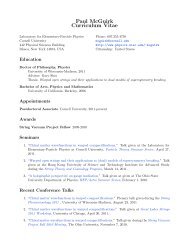
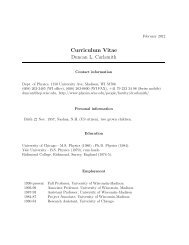
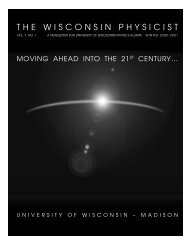
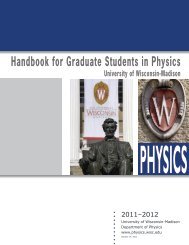

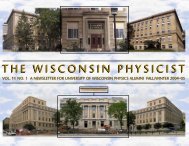

![The Symmetric Linear Potential [ ]](https://img.yumpu.com/25329322/1/190x245/the-symmetric-linear-potential-.jpg?quality=85)
